The 2022 Virginia Museum of Natural History’s (VMNH) Dino Festival attracted a record-breaking crowd through the doors of the state’s natural history museum during the two-day event.
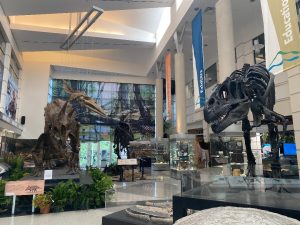
As the second and final day of the festival began drawing to a close on Saturday, VMNH Deputy Director Ryan Barber said that an initial count totaled 4,604 visitors to the museum over the weekend.
“This is, by far, a record attendance,” he said, and noted that the museum’s previous record for any of its festivals was 3,500 for 2019’s Dino Fest, the last dinosaur event held before the pandemic.
Museum Director Dr. Joe Keiper said that while the number of attendees was not wholly unanticipated, staff were “cautiously optimistic” going into the event, “because, while we’ve ramped up our operation, we’ve seen a trend in increasing attendance.
“It’s difficult to predict, but it seems as we moved further and further away from 2020 (the year COVID-19 struck),” Keiper said. “People want good, quality opportunities to have fun, to learn, to see unique things, and to interact with interesting people.”
He said the people component played a big role in the draw of Dino and other museum festivals. “Putting staff on the floor is one of the great assets of our festivals and it seems, potentially, that people were hungry for that.”
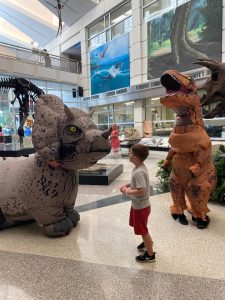
The thousands in attendance enjoyed activities including face painting, balloon animals, a photo booth, and the chance to interact with living monitor lizards, as well as exploring the museum’s galleries. The main attraction, of course, were the many cast skeletons and actual bones of the ancient creatures that walked the earth millions of years ago, as well as the museum’s team of scientists and educators stationed around the museum to discuss the details of everything from fossilized bugs to long-necked giants to the plates of the stegosaurus to an ancient battle between a T-rex and a triceratops.
Dr. Adam Pritchard, assistant curator of paleontology, manned a station that taught visitors about the varying size of dinosaurs, the largest of which, he said, were called sauropods, better known as the long-necked dinosaurs.
Laid out on the floor by Pritchard were the hip, thigh, shank, and foot of one such dino to help demonstrate the huge size of the animals “and hopefully capture a little bit of the scale of this kind of dinosaur and how it compares and outclasses the largest living animals,” Pritchard said.
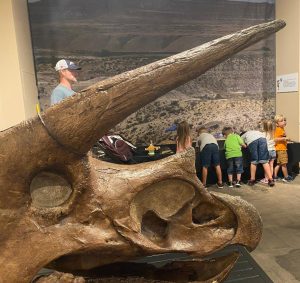
Early dinosaurs, however, “were nowhere near the size and scale of the things we see much later in time, like the sauropods,” Pritchard said. A life-size model of another, much smaller, dinosaur, called an eoraptor, which lived long before sauropods, was on display in the room to illustrate the stark difference. The entire eoraptor model dwindled in size when compared to the sauropod leg bones to its left.
“We’re trying to capture the idea that dinosaurs started out quite small and only later developed the incredible size that we typically associate with them,” Pritchard said.
He explained that dinosaurs first appeared in the Triassic period among other, larger, reptile groups. Those other groups went extinct at the end of the Triassic “and that’s pretty much when
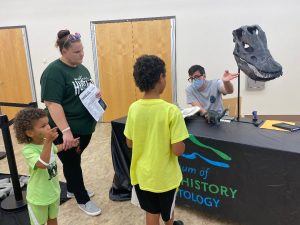
dinosaurs start to increase in body size, but they did so to a degree that’s absolutely unprecedented.” Sauropods, for example, “by a very large factor are the largest land animals that have ever lived. The largest sauropods are at least the weight of five modern elephants. Even an animal that isn’t one of the ‘big’ dinosaurs, like triceratops, is still the size of an elephant.”
Why the ancient animals grew so large, however, remains a mystery. “It’s a standing mystery of paleontology,” Pritchard said.
Many visitors who explored the downstairs area of the museum were drawn into one classroom by a sign which read, “view one of the most important fossils ever discovered!”
Inside the darkened classroom was a single, large case. Within
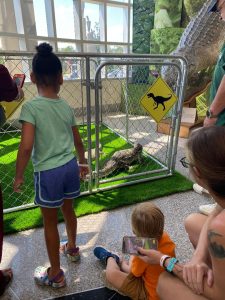
were two horns of a Triceratops. Within, visitors learned that the fossils, which are in the VMNH collection, are the only known evidence of a Tyrannosaurs rex fighting a live Triceratops.
Keiper explained to one group of visitors that it was previously believed that T. rex was only a scavenger, not a hunter. The horns of the Triceratops feature bite marks that, due to the spacing, could only have been made by a T. rex, indicating that the meat-eater tried to kill what it hoped would be its next meal, disproving the theory that it only scavenged animals that were already dead.
X-rays of the fossil show much denser bone in the places the Triceratops horn was bitten, which is a sign of healing and indicates that the Triceratops survived its battle with the T. rex.
In another area of the museum, Dr. Kal Ivanov, assistant curator of invertebrate zoology, and Dr. Jackson Means, myriapodologist, shared with visitors the fossils of invertebrates—insects, clams, trilobites, and other,
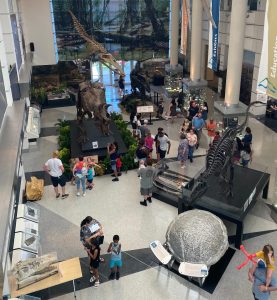
much smaller, creatures that people may not necessarily think about when they imagine the ancient world but which, in some cases, lived long before the dinosaurs ever walked the earth.
“Most (of these invertebrates) aren’t around anymore except for this horseshoe crab,” Means said, indicating one of the specimens on display. “The group is about 480 million years old (dinosaurs emerged a mere 225 million years ago), and you can still find them today.”
Some of the insect fossils included in the display were ancient flies and beetles which had been preserved in amber—tree sap that encases the insect and then hardens. Though the amber fossils were found near the Baltic Sea, others, found in shale deposits, were discovered much closer to home.
Ivanov said there is a local quarry, right on the Virginia/North Carolina border and just north of Eden, NC, where such shale fossils
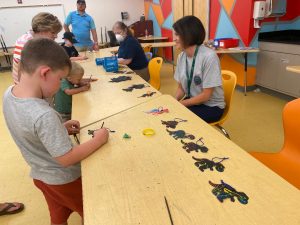
could be found. The Solite Fossil Site was the site of an ancient lake,” Ivanov said, “that’s why it’s really abundant in aquatic invertebrates and it’s one of the best-preserved insect fossil beds from that time in the world, and it’s just 30 minutes down the road from the museum. We have the largest number of specimens from that period (of time) in the museum,” he said.
Means said that fossilized insects and invertebrates, while perhaps not as popular as dinosaurs, are still important to understanding, not only the past, but the present.
“A lot of fossilized insects are going to be representative of extant orders,” he said, “so groups of insects that are still alive today, you can look at evolutionary history and how those things have changed over time. They also can be representative of groups we don’t have today, and that can be really exciting, when you see something that has lineage that has disappeared—when something is not quite a beetle, not quite a fly, something like that. There are a lot of mysteries, millions and millions of years, tons of species, we have no idea what they are, so there’s a lot of potential for brand new groups. But there’s also information about our currently existing creatures.”
Fossils can also help researchers learn how various structures possibly evolved, Ivanov added. Structures such as wings. “Modern insects have them, but how did they arise? What structures were they? How did they first learn to fly? Why did they (begin to fly?) That can only be explained in the fossil record.”
“There are insects, for example, which used to have three pairs of wings instead of just the two that we have today,” said Means. “We wouldn’t have known that if we didn’t have fossils. That’s pretty wild. For some reason, they lost that first pair of wings. We don’t necessarily know why.”
Across the two days of the festival, visitors young and old wandered the galleries and hallways of the VMNH, gazing in awe at real and replicated skeletons of ancient creatures large and small, real-world evidence that dinosaurs, though long dead, clearly continue to fascinate.
Pritchard, who has made his career studying the ancient creatures, attributes the power of dinosaurs to live on in our imaginations to a number of factors.
“I think it is size,” he said, “these animals are on a scale that we can imagine and understand but is still so much greater than what we deal with today. It draws attention. What draws me in is the incredible range of shape and roles in the ecosystem—giant predators, giant plant-eaters, armor, horns, all these different features that we see in different groups of dinosaurs that make them diverse and fascinating and alien to the modern world.”



